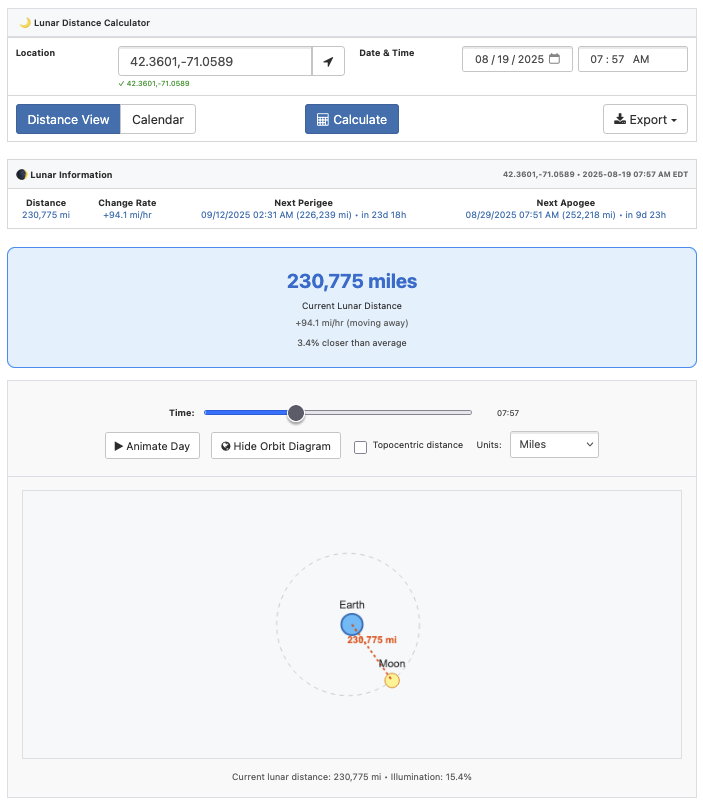Track the Moon's distance from Earth in real-time with our interactive lunar distance calculator. See live distance updates, supermoon/micromoon alerts, and animated orbital diagrams showing exactly how far away the Moon is right now.
The Moon is 241,159 miles (388,108 km) from Earth as of December 23, 2025 10:43 PM UTC.
Lunar distance calculator
Using the lunar distance calculator
The calculator detects your location, lets you search through 150,000+ cities, or lets you enter a latitude and longitude directly. See moon distance updates in real-time as you drag the time slider, and you can animate through a full day to watch the Moon's orbit in action.
Real-time distance tracking
- Current Distance: Live lunar distance in miles or kilometers, updating as you change time or location
- Distance Rate: How fast the Moon is moving toward or away from Earth (which changes throughout the orbit)
- Next Perigee/Apogee: Countdown to the Moon's next closest and farthest approach with exact times
- Supermoon and Micromoon Detection: Automatic alerts when a Full Moon is unusually close or far
- Time Animation: Hit Animate Day to watch the Moon's distance change hour by hour
The distance changes more than you'd expect - up to 2,000 miles in a single day as the Moon follows its elliptical orbit!

Interactive orbit visualization
Click the Show Orbit Diagram button to see a live orbital diagram that updates as you change the time:
- Elliptical Orbit Model: Shows the Moon's elliptical path around Earth (it's not a perfect circle, you know...)
- Real-Time Position: The Moon's current location on its orbit, updated live as you drag through time
- Distance Visualization: A connecting line shows the current Earth-Moon distance
- Illumination Percentage: Current Moon phase illumination
Advanced distance calculations
There's a Topocentric distance option you can check that estimates the distance from your specific location on Earth's surface rather than Earth's center. This adds about 2% variation based on where you are:
- Geocentric Distance: Standard measurement from Earth's center (what most sources report)
- Topocentric Distance (when checked): From your actual location, accounting for Earth's rotation and your position on the surface
Monthly perigee/apogee calendar
Switch to Calendar view to see all the Moon's closest and farthest approaches for any month:
- Perigee Events: When the Moon reaches its closest approach (around 356,000-370,000 km)
- Apogee Events: The Moon's farthest point (about 404,000-406,000 km away)
- Supermoon and Micromoon Highlights: Full moons that coincide with perigee or apogee for maximum or minimum apparent size
- Export Options: Download monthly data as CSV or save orbital diagrams as SVG files
Lunar distance science
The Moon's distance varies dramatically because it follows an elliptical orbit, not a perfect circle. At perigee (its closest approach), it can be as close as 356,500 km. At apogee (its farthest point), it retreats to over 406,700 km - a difference of about 31,000 miles!
Calculation accuracy
- Lunar positions: Uses the SunCalc library with calculations accurate to within a few kilometers
- Cities database: Location data from cities.json covering 150,000+ worldwide locations
Always verify calculations for critical astronomical observations – use the tool as a starting estimate. The Moon's orbit is complex and affected by solar perturbations that can introduce small variations.
Related moon and astronomy tools
Track more lunar, solar, and other various celestial events with these related calculators:
- Moon Phase Calculator - Complete lunar cycle tracking and moon path visualization
- Sunrise Sunset Calculator - Sun timing today
- Sun Angle Calculator - Solar position and shadow calculations
- Day Night World Map - Global daylight patterns in real-time
- Hours Between Calculator - Time calculations for any span
- Solar Panel Angle Calculator - Optimize panel positioning for maximum energy
- Daylight Hours Graph - Compare seasonal daylight patterns
- Time Zone Conversion Calculator - Convert times across global zones
- World Clock - Live time in major cities worldwide
- Days Between Dates - Calculate spans between any two dates
The Moon might be 238,855 miles away on average, but your calculations are... a few milliseconds away. (And yes, Han Solo told me you can compare distances to times, it's fine.)
